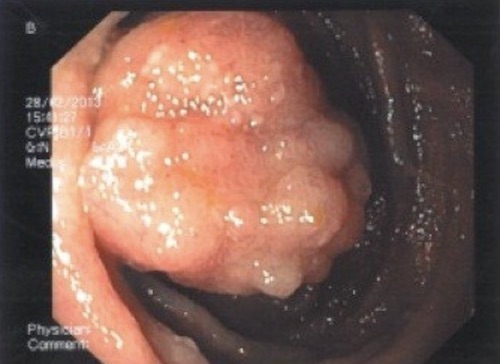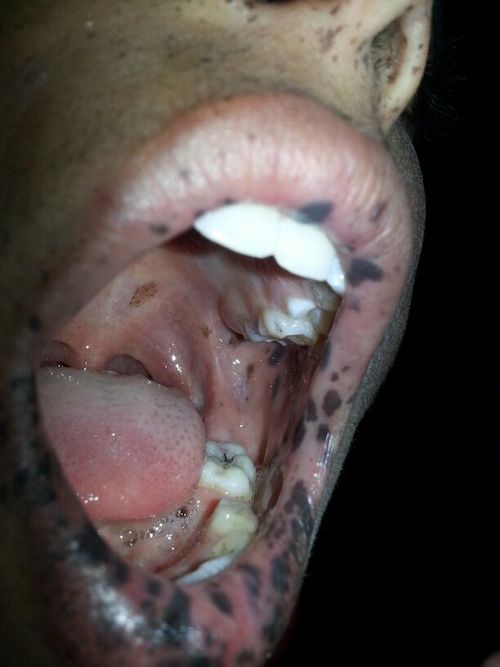Peutz-Jeghers Syndrome (PJS)
Jackson Phillip Bauer, MD
The Operative Review of Surgery. 2023; 1:134-137.
Table of Contents
Pathophysiology and Presentation
Also Known as “Polyps and Spots Syndrome” or “Hutchinson Weber-Peutz Syndrome”
Genetic Mutation 1
- Mutation: STK11/LKB1 Gene Mn
- Autosomal Dominant
- Distribution of Polyps: 2
- Small Bowel (64%) – Classically in the Jejunum
- Colon (53%)
- Stomach (49%)
- Rectum (32%)
- Can Present with Nausea, Vomiting, Abdominal Pain, Obstruction, and GI Bleed 1
- Symptoms Generally Start Around Age 10-30 1
- Half of Patients Require Surgery by Age 18 1
- Risk or Cancer: 3
- Colorectal Cancer: 39%
- Stomach: 29%
- Small Bowel: 13%
- Timing: 5
- Rarely Present at Birth
- Pronounced Before Age 5
- May Fade in Puberty/Adulthood
- Locations: 5,6
- Buccal Mucosa (65%)
- Face Around Mouth, Eyes, and Nostrils
- Perianal Region (94%)
- Fingers (73%)
- No Associated Malignancy Risk
- Breast Cancer (32-54%)
- Benign Ovarian SCTATs (Sex Cord Tumors with Annular Tumors) (21%)
- Cervical Cancer (10%)
- Uterine Cancer (9%)
- Testicular Cancer (Sertoli Cell Tumor) (9%)
- Pancreatic Cancer (11-36%)
- Lung Cancer (7-17%)

Peutz-Jeghers Intestinal Hamartoma on Endoscopy 4

Melanin Spots of Buccal Mucosa 7
Diagnosis and Management
Diagnosis
- Clinical Diagnosis: (One of the Following) 8
- Two or More Histologically Confirmed PJS-Type Hamartomatous Polyps
- Any PJS-Type Polyp with a Family History of PJS in a Close Relative
- Mucocutaneous Hyperpigmentation with a Family History of PJS in a Close Relative
- Any PJS-Type Polyp with Mucocutaneous Hyperpigmentation
- Molecular Diagnosis Established by Genetic Testing 8
Surveillance 5
- Triple-Endoscopy (Colonoscopy, Upper Endoscopy, and Video Capsule Endoscopy)
- Baseline at Age 8
- If Polyps are Founds: Repeat Every 1-3 Years
- If Polyps Not Found: Repeat at Age 18 and Every 2-3 Years After
- Breast MRI and Mammogram Every Year, Starting at Age 30
- Clinical Breast Exams Starting at Age 18
- Pelvic Exams:
- Testicular Exam Every Year Starting at Age 10; May Consider Testicular US as Well
- Pelvic Exam and Pap Smear Every Year Starting at Age 18-20
- EUS or MRCP Every 1-2 Years, Starting at Age 30-35
- Consider Annual Chest Radiograph or CT in Smokers – Otherwise No Need for Lung Cancer Screening 3
Prophylactic Surgery
- Prophylactic Mastectomy and/or Prophylactic Hysterectomy and Bilateral Salpingo-Oophorectomy (TH-BSO) May Be Considered 5
- Not Specifically Studied with Poor Evidence to Guide Practice 5
- No Indication for Prophylactic Colectomy
Other Colorectal Cancer and Polyposis Syndromes
Syndromes
- Familial Adenomatous Polyposis (FAP)
- Lynch Syndrome
- Juvenile Polyposis Syndrome (JPS)/Familial Juvenile Polyposis
- MUT Y Homolog (MUTYH)-Associated Polyposis (MAP)
- Peutz-Jeghers Syndrome (PJS)
- Serrated Polyposis Syndrome (SPS)
- PTEN Hamartoma Tumor Syndromes: (PHTS)
Comparisons
Mnemonics
Peutz-Jeghers Syndrome Genetic Mutation
- Mutation: STK11
- Melanin Spots of Buccal Mucosa Look Like a Mouth Filled with “Skittles” – STK11
References
- Leveille E, McGarrity TJ. Peutz Jeghers Syndrome. National Disorder of Rare Disorders. 2018.
- Tse JY, Wu S, Shinagare SA, Lauwers GY, Yilmaz O, Wu CL, Deshpande V. Peutz-Jeghers syndrome: a critical look at colonic Peutz-Jeghers polyps. Mod Pathol. 2013 Sep;26(9):1235-40.
- Syngal S, Brand RE, Church JM, Giardiello FM, Hampel HL, Burt RW. Clinical Guideline: Genetic Testing and Management of Hereditary Gastrointestinal Cancer Syndromes. Am J Gastroenterol. 2015;110:223–62.
- Jelsig AM, Qvist N, Brusgaard K, Nielsen CB, Hansen TP, Ousager LB. Hamartomatous polyposis syndromes: a review. Orphanet J Rare Dis. 2014 Jul 15;9:101. (License: CC BY 4.0)
- McGarrity TJ, Amos CI, Baker MJ. Peutz-Jeghers Syndrome. 2001 Feb 23 [updated 2021 Sep 2]. In: Adam MP, Mirzaa GM, Pagon RA, Wallace SE, Bean LJH, Gripp KW, Amemiya A, editors. GeneReviews
- Utsunomiya J, Gocho H, Miyanaga T, Hamaguchi E, Kashimure A. Peutz-Jeghers syndrome: its natural course and management. Johns Hopkins Med J. 1975;136:71–82.
- Sarhan A. Wikimedia Commons. (License: CC BY-SA 4.0)
- Beggs AD, Latchford AR, Vasen HF, Moslein G, Alonso A, Aretz S, Bertario L, Blanco I, Bülow S, Burn J, Capella G, Colas C, Friedl W, Møller P, Hes FJ, Järvinen H, Mecklin JP, Nagengast FM, Parc Y, Phillips RK, Hyer W, Ponz de Leon M, Renkonen-Sinisalo L, Sampson JR, Stormorken A, Tejpar S, Thomas HJ, Wijnen JT, Clark SK, Hodgson SV. Peutz-Jeghers syndrome: a systematic review and recommendations for management. Gut. 2010;59:975–86.